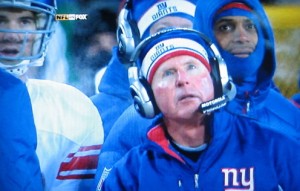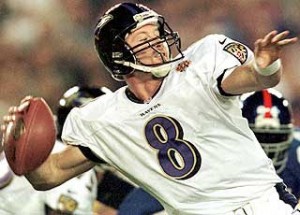Let’s start by recognizing that the 2011 Giants faced a difficult schedule in the regular season; not only was the NFC East competitive, but New York also faced the top four teams in the NFL outside of their division. In 2011, the Giants ranked 13th in the Simple Rating System. For the uninitiated, the SRS is a predictive system, which means it could theoretically place a 3-5 team ahead of a 7-1 team. The SRS mimics the points spread you would see in Las Vegas rather than a power ranking system. As the name implies, it’s simple in the sense that it only looks at two variables: strength of schedule and margin of victory. Each game is given equal weight. A win by 10 points over a team that is 5 points below average is equal to a 5-point win over an average team. The SRS is always just the sum of the margin of victory and the opponent’s rating. Unlike many systems, in the SRS, the values have meaning. A team with an SRS rating of +6.0 means that team is six points better than average.
It’s complicated to create these ratings, but I’ve done the heavy lifting [1]The tricky part is that each team’s strength of schedule is dependent on the ratings of each of their opponents, which is dependent on the ratings of each of their opponents, which includes the … Continue reading. Here were the SRS ratings for each team immediately after week 17 last season:
While the 2011 Giants were outscored by 0.4 points per game, they weren’t really below average because they faced the third toughest schedule in the NFL. We can actually see exactly why the Giants ended up at +1.6 in the SRS by looking at the final scores of each of their regular season games. Each game below contains a “MOV” column, which is simply the difference between points scored and points allowed along with a three-point adjustment for home field. The second to last column shows the SOS of the opponent, which matches the rating given to that team in the above table. The final column shows the rating assigned to New York for each game, which of course averages to +1.6.
While there’s some merit to the claim that New York peaked at the end of last year, note that their worst game of the season came in week 15 against the Redskins. In fact, the Giants two worst games of the year came against Washington. Along with home losses to the Seahawks and Eagles, an embarrassing performance in New Orleans, and unimpressive home wins against the Bills, Rams and Dolphins, it’s easy to see why it was so surprising to see the Giants run the table in the post-season.
But there’s no reason to ignore New York’s post-season success. At a minimum, we can simply include each of those games and assign them the same weight as each regular season matchup. If we re-run the SRS program using all 267 games last year — and not just the 256 regular season games — here are the updated standings:
The Giants move up from 13 to 6, and now appear to be 5.3 points better than average. But the SRS tells us if the Giants played any of the teams ranked above them — even after their Super Bowl win — they’d likely have been underdogs.
That’s because the 2011 Giants had incredible but unexpected post-season success. They were 1.6 PPG better than average during the regular season, but if you include all 20 games they played, they were 5.3 PPG above average. By playing in the post-season, they increased their SRS score by 3.7 points, the second most of any team since 1990. Take a look at the table below, which shows all teams who increased their total SRS score by at least 2 full points thanks to their post-season success:
I looked at another sample of teams [2]I looked at the 33 teams from 1990 to 2010 who played in either 0 or 1 post-season games and had a Total SRS score of between 4.4 and 6.4. Their average SRS score was 5.3. who had an average SRS score of 5.3; in the next season, they declined to just 3.4 points better than average. So the 11 teams who had an average SRS score of 5.4 points better than average in the regular season but followed it with a great post-season held their success better than the control group. That’s another sign that we should not just consider the Giants as a 9-7 team.
New York still has holes, and didn’t necessarily get better in the off-season compared to the other Super Bowl favorites. I don’t think they were the best team in the league last season, but even if you count a post-season game as being equal to a regular season game, they were in the top quarter of the league. That’s probably a reasonable projection for them again in 2012.
Previous “Random Perspective On” Articles:
AFC East: Buffalo Bills, Miami Dolphins, New England Patriots, New York Jets
AFC North: Baltimore Ravens, Cincinnati Bengals, Cleveland Browns, Pittsburgh Steelers
AFC South: Houston Texans, Indianapolis Colts, Jacksonville Jaguars, Tennessee Titans
AFC West: Denver Broncos, Kansas City Chiefs, Oakland Raiders, San Diego Chargers
NFC East: Dallas Cowboys, New York Giants, Philadelphia Eagles, Washington Redskins
NFC North: Chicago Bears, Detroit Lions, Minnesota Vikings, Atlanta Falcons
NFC South: Atlanta Falcons, Carolina Panthers, New Orleans Saints, Tampa Bay Buccaneers
NFC West: Arizona Cardinals, San Francisco 49ers, Seattle Seahawks, St. Louis Rams
References
| ↑1 | The tricky part is that each team’s strength of schedule is dependent on the ratings of each of their opponents, which is dependent on the ratings of each of their opponents, which includes the original team we’re trying to rate. If you adjust each team’s rating over thousands of iterations, eventually the ratings converge, and we’re left with “true” ratings |
|---|---|
| ↑2 | I looked at the 33 teams from 1990 to 2010 who played in either 0 or 1 post-season games and had a Total SRS score of between 4.4 and 6.4. Their average SRS score was 5.3. |


